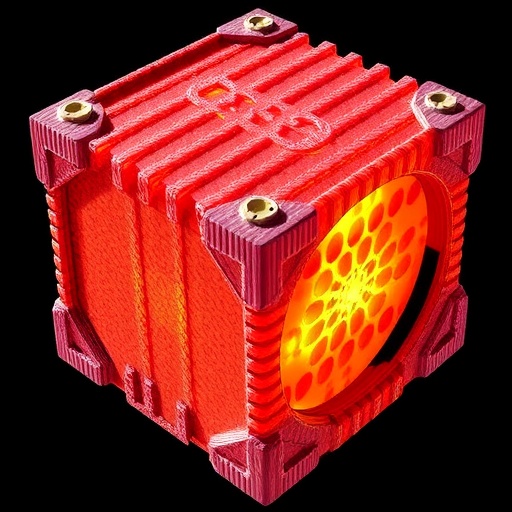Researchers have long understood that when a spacecraft reenters Earth’s atmosphere, the outer surface of its heat shield is sacrificed to protect the structural integrity of the vehicle. The essential role of heat shields is to dissipate heat generated during reentry, but the conventional view held that the degradation occurred solely at the surface level. Recent groundbreaking research conducted by scientists at The Grainger College of Engineering at the University of Illinois Urbana-Champaign, in collaboration with multiple prestigious institutions, challenges this notion. Their findings shed light on the complex degradation mechanisms of ablative carbon fiber materials under varying thermal conditions, revealing significant oxidation occurring not just on the surface but also deep within the material.
The team focused on understanding the intricacies of carbon fiber oxidation, a critical factor in thermal protection system performance. This research project was inspired by longstanding theories in material science that provided a framework for understanding oxidation processes. According to the lead researcher, Francesco Panerai, the team designed a series of meticulously executed experiments that brought to life the theoretical models established in previous studies, resulting in unexpected observations that are reshaping current knowledge in heat shield technology.
Experiments were conducted at the renowned Berkeley Lab Advanced Light Source and the Paul Scherrer Institute in Switzerland, utilizing cutting-edge technology to investigate material degradation in real-time. The researchers employed the TOMCAT beamline at the Swiss Light Source, which is uniquely suited for tracking dynamic processes in materials. This facility features an ultra-fast end station with a specialized camera system that resolves micron-scale structures over sub-second timescales. By exposing small samples of ablative carbon fiber to extreme heat and bright X-ray radiation, the team was able to capture a series of 3D images that illustrated the material’s degradation as it was consumed by oxygen.
The capability of observing fiber ablation at unprecedented detail was a game-changer. The raw data collected, totaling around 19 terabytes, posed significant challenges in terms of processing and analysis. Benjamin M. Ringel, a key member of the research team, undertook the monumental task of reconstructing the complex datasets. In doing so, he utilized deep learning techniques to segment the data, isolating the carbon fibers from the void spaces to visualize the oxidation processes occurring within the material’s depths. The interplay of oxygen diffusion and the chemical reaction with carbon fibers became clear, highlighting how temperature variations profoundly influence these behaviors.
As the temperature of the experimental conditions varied, the researchers observed crucial differences in how readily oxygen could penetrate the material. At high temperatures, rapid reactions at the surface resulted in oxygen getting consumed before it could diffuse deeper into the carbon fiber matrix. Conversely, lower temperatures slowed down the reaction rates, granting oxygen the necessary time to permeate through the material. This crucial finding indicates that degradation does not occur uniformly but rather is heavily influenced by temperature and pressure conditions during a spacecraft’s re-entry.
Moreover, capturing these dynamics allowed the researchers to quantify the extent of degradation within the material, creating a detailed map of how deep oxidation occurred based on specific thermal and mechanical conditions. Utilizing non-dimensional analysis, they could describe the balance between diffusion rates and reaction kinetics, providing a clearer perspective on the material’s behavior. The results were corroborated by the visual data collected, demonstrating a coherent relationship between the experiments and theoretical expectations.
Collaboration with NASA’s Ames Research Center played a pivotal role in the second phase of their analysis. By employing NASA’s Porous Microstructure Analysis software on one of the most advanced supercomputers in the country, the researchers were able to simulate over 1,600 material property scenarios. These simulations were informed by the evolving 3D images obtained from the TOMCAT beamline experiments, allowing the team to assess how the material properties transformed over time and space.
This comprehensive approach yielded insights about the mechanical properties of the carbon fiber heat shields under diverse operational scenarios. For the first time, the researchers could visualize how the properties of the material changed with varying diffusion and reaction conditions, leading to a new understanding of how heat shields degrade during flight. This remarkable advancement has significant implications for enhancing the design and functionality of heat shields used in modern aerospace applications.
This study not only enriches the scientific community’s knowledge base but also presents valuable measurements that heat shield researchers can use to refine their ablation models. As researchers improve their understanding of the intricate mechanisms driving heat shield degradation, the potential for innovative engineering solutions becomes increasingly evident. Concepts such as 3D-printed heat shields, intricately designed to exhibit precise internal structures and tailored for specific hypersonic reentry conditions, are now conceivable as a result of this research.
Ultimately, the findings highlighted in this study could pave the way for future advancements in thermal protection systems, facilitating safer and more efficient spacecraft reentry operations. As researchers continue to build upon these insights, they will contribute to better engineering practices, ultimately leading to improved missions and potentially new frontiers in space exploration.
This research adds another layer to the ever-evolving field of material science by providing empirical data that questions long-held assumptions about material behavior under extreme conditions. As scientists continue to explore the applications of this knowledge, the future holds promise for further innovations in the realm of aerospace engineering.
The culmination of this work is documented in the article titled “Carbon Fiber Oxidation in 4D,” which is set to be published in the esteemed journal Advanced Materials. The findings underscore the criticality of this research and its vast potential to influence future designs for spacecraft heat shields, thereby enhancing the safety and performance of missions that aim to explore the cosmos.
Subject of Research: Carbon Fiber Oxidation in Heat Shields
Article Title: Carbon Fiber Oxidation in 4D
News Publication Date: 14-Jul-2025
Web References: DOI link
References: Advanced Materials Journal
Image Credits: The Grainger College of Engineering at the University of Illinois Urbana-Champaign




